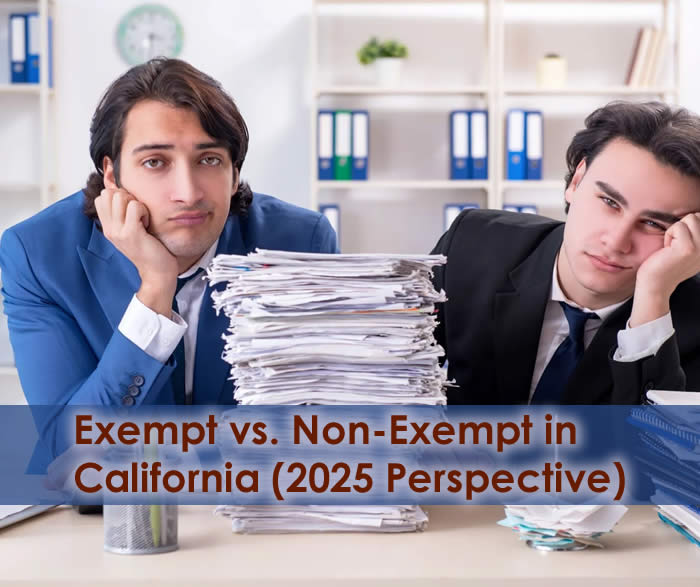Exempt vs. Non-Exempt in California (2025 Perspective)

✅ Exempt vs. Non-Exempt in California (2025 Perspective)
California continues to lead the nation in worker protection laws, and in 2025, the line between exempt and non-exempt is more important — and more scrutinized — than ever.
🔹 Why It Matters in 2025
- Wage theft lawsuits and employee misclassification are still major legal issues in CA.
- Remote/hybrid work and tech industry roles are blurring traditional job duties, making exemption status trickier.
- Minimum wage increases raise the salary threshold for exempt status.
🧾 Key Differences
| Exempt | Non-Exempt |
|---|
| Overtime Pay | ❌ Not entitled | ✅ Required by law |
| Breaks | ❌ Not guaranteed by law | ✅ Meal and rest breaks mandatory |
| Salary Basis | ✅ Must be salaried | ❌ Can be hourly or salaried |
| Wage Laws | ❌ Some exemptions apply | ✅ Fully protected under wage/hour laws |
| Duties Test | ✅ Must pass duties test | ❌ Duties test not needed |
| Job Examples | Managers, engineers, professionals | Admins, retail, hourly staff, most technicians |
💵 2025 Exempt Salary Threshold (California)
To legally classify someone as exempt, their salary must be:
- At least 2x the CA minimum wage for full-time work.
- In 2025, the statewide minimum wage is $16/hr, so the exempt minimum is:
$66,560 per year
(2 × $16/hr × 40 hrs/week × 52 weeks)
⚠️ Some cities (like SF, LA) have higher minimum wages — if applicable, that raises the local exempt salary requirement.
🧠 The “Duties Test” Still Matters
Even if someone earns $80k+, they’re not exempt unless they perform qualifying exempt job duties, like:
- Managing people (supervisors)
- High-level decision-making (admins with discretion)
- Licensed professionals (lawyers, doctors, etc.)
Job title alone doesn’t make someone exempt.
🚩 Common 2025 Issues
- Startups misclassifying employees to avoid overtime
- Remote workers doing non-exempt work but being paid a salary
- Pay compression: roles once exempt no longer meet new salary thresholds
- Gig work & tech jobs trying to fit into exemption categories (still a legal battleground)
✅ Best Practice for Employers (2025)
- Audit roles regularly
- Watch for “manager” titles with no real authority (classic red flag)
- Track hours for salaried workers if you’re unsure
- Consult HR/legal when hiring for gray-area roles